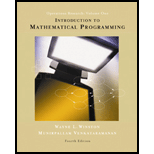
Concept explainers
Explanation of Solution
Solving the LP using simplex
Given,
Maximize
Subject to,
Converting to standard form:
As,
The standard form of LP problem becomes,
Maximize,
Subject to,
and
Converting LP to canonical form:
The LP is converted to canonical form by adding slack, surplus and artificial variables as appropriate. This is done as given below,
As the constraint “
For the constraint “
Thus the LP becomes,
Maximize
Subject to,
Iteration 1:
| 2 | 1 | -1 | 0 | 0 |
Min Ratio | |||
| 0 | 6 | (3) | 1 | -1 | 1 | 0 | ||
| 0 | 4 | 1 | 1 | -1 | 0 | 1 | ||
| z=0 | 0 | 0 | 0 | 0 | 0 | |||
| -1 | 1 | 0 | 0 |
Negative min
Minimum ratio is 2 and its row index is 1,
Want to see the full answer?
Check out a sample textbook solution
Chapter 4 Solutions
Introduction to mathematical programming
- Q1: For these Value Obtain U and V and evaluate W when Z = V5 – 2i Q2: If Z1= 4i-3 Z2= 3i Z1+Z2 Find Z2 (2x² x 2 2 Q3: if f(x) = 4 x < 2 find f(x)dx Q4: Show that f (z) = 2z3 – 4z + 1 is satisfy Cauch-Rieman %3D if Z in Cartesian formarrow_forward1. Use simple fixed-point iteration to locate the root of f(x) = sin (√) - x Use an initial guess of xo = 0.5 and iterate until & ≤ 0.01%.arrow_forward2- Solve the following system X+y-22=3 2x+y=17 x+y-z=4arrow_forward
- Solve the following system of equations by Gaussian elimination method. 2x1 − x2 + x3 = 1 4x1 + x2 − x3 = 5 x1 + x2 + x3 = 0arrow_forwardWhat is the value of x after the 5th iteration of performing fixed-point iteration on the equation f(x) = x3 –x – 2? (Use the equation where the root converges and use an initial guess of 1) Group of answer choices 1.2599 1.5206 1.5158 1.5213arrow_forwardLet x and y be integers such that x = 3 (mod 10) and y = 5 (mod 10). Find the integer z such that 97x + 3y³ z (mod 10) and 0 ≤ z ≤9.arrow_forward
- Current Attempt in Progress The accompanying figure shows known flow rates of hydrocarbons into and out of a network of pipes at an oil refinery. 200 E X3 D 150 X5 X₁' 200 25 A B x2 175 C (a) Set up a linear system whose solution provides the unknown flow rates. 25 X2 175 X3 Find A so that Ax=y where = and y = 200 THO 150 200 Form the system so that the first equation represents node A, the second equation node B, etc. Then take all the variable to one side such that all the constants are on one side and positive. From the equations form the required matrices and enter the appropriate values for A below. A =arrow_forward(a) ged(24, 54) = 6 (b) gcd(18,42) = 6 Now you try some: Answers (c) gcd(244, 354) = 2 (d) gcd(128, 423) = 1 (e) gcd(2415, 3289) = 23 (f) ged(4278, 8602) = 46 (g) gcd(406, 555) = 1arrow_forwardSolve the following problem for one step: dy dx =y+x² a) Use Euler's method to find y(2). b) Use Heun's method to find y(2). y(0)=1, 0≤x≤2, h=2arrow_forward
- Solve the following linear programming problem with a simplex table: 3x1+x2+5x3→max x1+x3≤12 x2+x3≤8 x1,x2,x3≥0 Advanced Algorithmsarrow_forwardTwo points on line 1 are given as (x1, y1) and (x2,y2) and on line 2 as (x3, y3) and (x4, y4), as shown in Figure 3.8a and b.The intersecting point of the two lines can be found by solving the following linearequations:(y1 - y2)x - (x1 - x2)y = (y1 - y2)x1 - (x1 - x2)y1(y3 - y4)x - (x3 - x4)y = (y3 - y4)x3 - (x3 - x4)y3This linear equation can be solved using Cramer’s rule . If the equation has no solutions, the two lines are parallel (see Figure). Write a program that prompts the user to enter four points and displays the intersectingpoint. Here are sample runs:arrow_forwardSolve the following systems of linear equations via matrix algebra: –3x + 2y – z = –1 6x – 6y + 7z = –7 3x – 4y + 4z = –6 Using iterative method show the step-by-step solution similar to the derivation of each method presentedarrow_forward
 Operations Research : Applications and AlgorithmsComputer ScienceISBN:9780534380588Author:Wayne L. WinstonPublisher:Brooks Cole
Operations Research : Applications and AlgorithmsComputer ScienceISBN:9780534380588Author:Wayne L. WinstonPublisher:Brooks Cole
